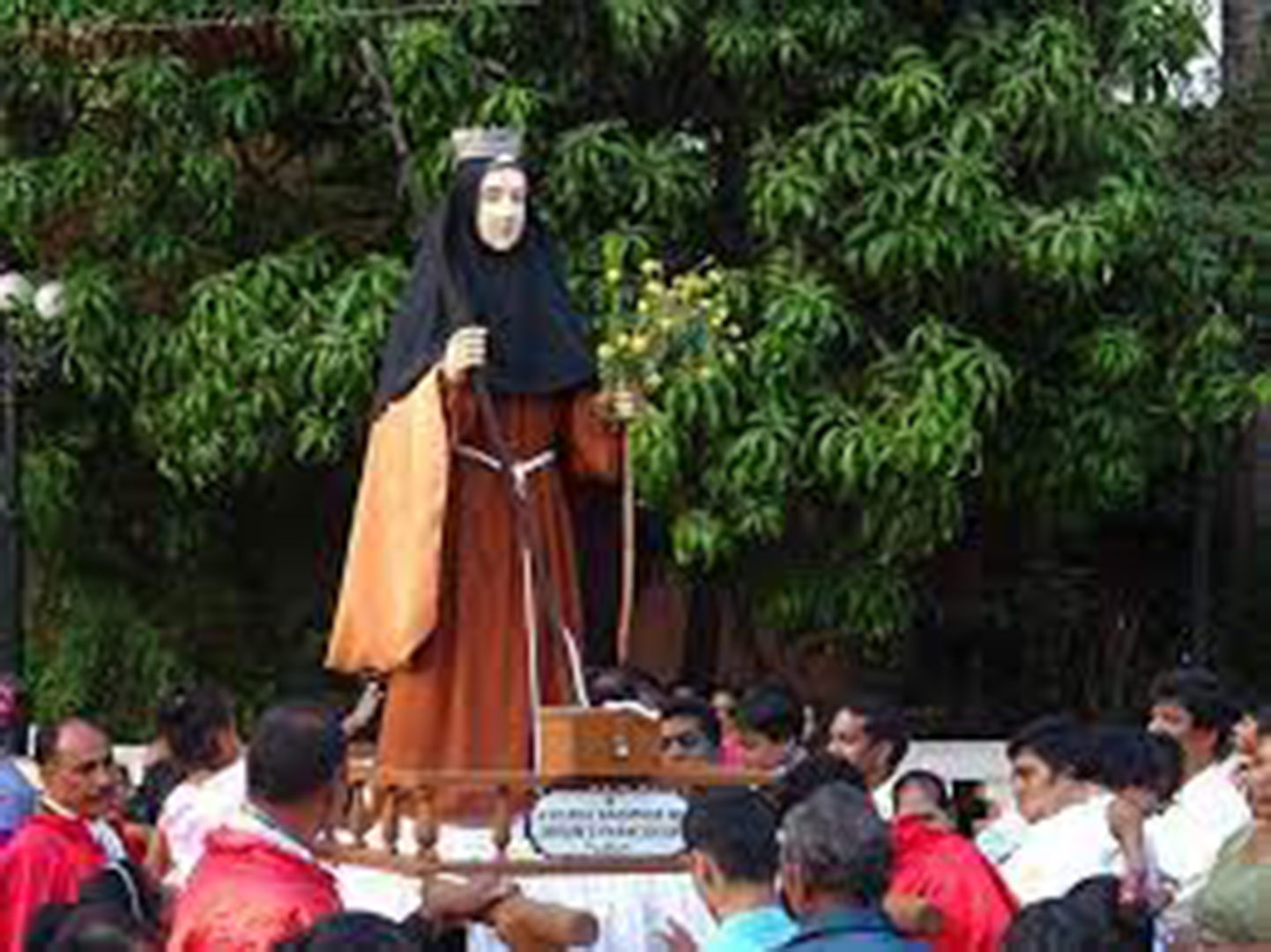Lenten Traditions in Goa
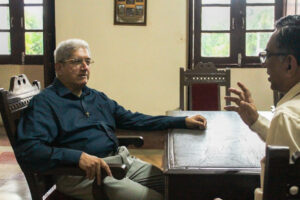
ON: What do you have to say about Goa's rich tradition of Lenten music?
JLP: Well, the Motetes (Motets) are Goa’s “classical” Lenten music. They began appearing by the middle of the 19th century. They were sung on the occasion of the Santos Passos (Holy Steps of the Cross) and also during the Sacred Triduum, that is, Maundy Thursday, Good Friday and Holy Saturday. This is Goan Lenten music par excellence. Enter Vatican II in the 1960s and as a result we now have many Lenten hymns – liturgical songs to be sung in church – all composed in the Konkani language, beginning from the year 1965.
ON: What might the earlier Lenten music have been, before the Motets came about in the middle of the 19th century?
JLP: I have no idea. They must have been only hymns in Latin because the liturgy was in Latin. The Parish Schools, for example, began in Goa way back in the 16th century. No Konkani music or hymns were taught there. It was only Latin. The students of our parish schools learnt even choral songs. They could sing in polyphony and they sang serious classical music, like Palestrina and later Perosi and others.
ON: The church Mestres (music teachers) must have also contributed a lot…
JLP: Yes, the Mestres of our Churches, who were also music teachers in our parish schools, used to compose a lot of music in Latin, especially Masses. I am from Benaulim and I met one or two Mestres in my childhood – one was Sabino Rebello and the other was some Roque whose surname I forget, who was the Mestre of St John the Baptist Church, Benaulim.
ON: Are there any studies on the Motets and the religious music of Goa?
JLP: Yes, there are certain studies made on the Motets. To my knowledge, one by Fr. Lourdino Barreto and the other by a Portuguese musicologist, Prof. Manuel Morais. Fr. Romeo Monteiro has published a booklet on this.
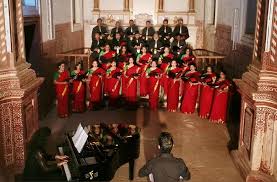
ON: Come to think of it, the Motet and the Mando belong to the same period!
JLP: Exactly, the Motet and the Mando came up in the second half of the 19th century. It was perhaps the fruit of what we could call a “compositional spurt” among Goan composers. At least for some hundred years in Goa, motets were composed in Latin. Perhaps in the nineteen fifties or a little earlier, they began composing motets in Konkani, like “Vell Mhozo Paulo” …
ON: Who composed it?
JLP: Look, we have a curious fact here. Manuel Morais has already found a number of motets, both in Latin and in Konkani, but there is no name of the composer!
ON: What could the reason be?
JLP: What he says is that perhaps the composers were few and widely known and hence there was no interest in knowing who had composed them.
ON: Let’s say, the composer of “Sam Francisku Xaviera”…
JLP: Raimundo Barreto! He is widely known for his iconic composition “Sam Francisku Xaviera”. I don’t know of any other composition by him. He probably has some.
ON: Would there be a way of collecting all the motets?
JLP: Yes. There are bound to be other motets, in private collections. Perhaps these Mestres, no longer alive today, have left in their trunks some other motets that are not known; but I doubt we shall ever know the names of the composers. That will be very difficult to find.
ON: So, at least regarding motets, we have surprises awaiting us…
JLP: I think so too.
ON: Let’s hope so! And now, let’s talk about music composed after the Vatican Council…
JLP: There are a number of composers, starting with Fr. Vasco do Rego. He was the pioneer of liturgical music in Konkani here in this diocese. We had religious songs in Konkani, even Lenten songs, which were not motets, like “Deva doiall kakutichea”, “Jezu mhojea tujer hanv patietam”. They are penitential hymns which most probably are one or even two centuries old. But the post-Conciliar impetus was given by Fr. Vasco do Rego. He composed many Lenten hymns and he was followed by others.
ON: And who would the others be?
JLP: Fr. Bernardo Cota, Fr. Lino de Sá, Fr. Santana Faleiro, Fr. Joe Rodrigues (this one is a junior priest, but has a couple of compositions)…
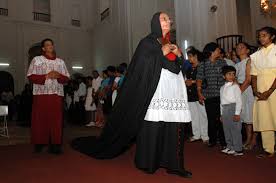
ON: And there must have been lay people…
JLP: Yes, there were lay people, too, like Alcântara Barros … and there was one who had been the Mestre of Verna church: I don’t remember his name.
ON: And Varela Caiado?
JLP: Well, I know Varela Caiado as the organist of our Cathedral in Old Goa. I don’t know him as a composer. I have no idea of any compositions by him. But he was a first-rate musician. He was the organist of our Cathedral: this is all I know of him.
ON: Are there productions of Lenten music brought forth by the Diocesan Commission for Sacred Music?
JLP: Yes, there are. I think there are at least two publications of Lenten sheet music, some loose leaflets, besides one or two audio compact discs.
ON: What would be some peculiarities of the Lenten rituals in Goa?
JLP: Well, we have traditions in Goa that are not followed elsewhere. First, the Santos Passos procession is something typical of Goa, and perhaps of a few other parishes which were part of the Diocese of Goa in times gone by, like Belgaum, Sawantwadi, Karwar: these places, which now belong to other dioceses, were part of the Archdiocese of Goa; so the Santos Passos are to be found there too. If one goes to Central India or South India or North India, no, no Santos Passos there. We have inherited this from Portugal, where the tradition still exists.
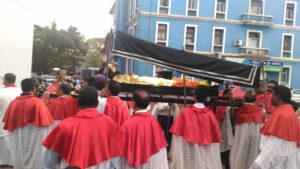
Here in Goa, the Santos Passos are an interesting event…. There are ‘two Goas’: North Goa and South Goa. In North Goa, Santos Passos are celebrated on every Sunday of Lent. If on the first Sunday of Lent one dwells on the Condemnation of Christ, the second Sunday is the Ecce Homo, on the third Sunday we have the Lord carrying the Cross, on the fourth Sunday, the Lord meeting his Mother on the way to Calvary, and so on: each Sunday offers a meditation on one of the Passos or steps of the Way of the Cross. They are not the fourteen stations, but just a few of them.
In South Goa, it is only one Sunday. For example, in Benaulim, it is the fifth Sunday, in Loutulim it is the third Sunday, and so on. Here you have only one procession of the Santos Passos, incorporating one or two or three Passos of the Way of the Cross.
Another tradition in Goa, both in North and South Goa: a child sings a Veronica hymn… Earlier on, the songs were only in Latin, but now there are Veronica songs in Konkani too.
ON: And the Procession of the Franciscan Saints?
JLP: Well, the Procession of the Terceiros: this too comes from Portugal! Here in Goa we know them as Terciários. In Portugal they are known as Franciscanos Terceiros or Franciscans of the Third Order. I wouldn’t know in which part of Portugal, but they still hold this procession of the Franciscan Saints over there. Here the procession is held only in one place: Goa Velha.
ON: But I’ve heard that Rome is the only other place where such a procession is held…
JLP: I’ve heard that too. If it’s true, I wouldn’t be able to say in which parish of Rome it is held. But I can tell you that there are a couple of parishes in Portugal where such a procession of Franciscan Saints is held: fourteen, fifteen andores (litters) are taken in procession, just like in Goa. But here, no longer are they Franciscan saints alone. There are other saints: Saint Joseph Vaz, the Patron of our Archdiocese, has already been added to the saints here. Don’t be surprised if one day the procession adds in Mother Teresa, Saint Teresa of Kolkata….
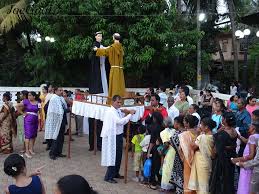
ON: But how did a Lenten procession of Franciscan Saints come about in the taluka of Ilhas or Tiswaddi, which was evangelized by the Dominicans?
JLP: Well, this procession, which takes place on the Monday following the Fifth Sunday of Lent, began in the Pilar Monastery, at a time when the Franciscan Capuchos lived there. When the Monastery was shut down, all those saints or images were lodged at the Parish Church of Goa Velha… Note that Pilar still belongs to the parish of Goa Velha, and it is this same parish that holds the procession every year.
ON: As we come to the end of this chat, may I ask you for a message for the season of Lent!
JLP: My message as a priest is that we should live the spirit of Lent as it should be: a spirit of penance, saying no to ourselves, all right, but not with ashes on our heads or sitting on sackcloth as they did in the Old Testament. Ours is a more joyful Lent, because the penance I make, I make it with love and with joy: I am anticipating the joy of the Lord’s Resurrection!
For the original audiovisual version in Portuguese, see Renascença Goa at https://www.youtube.com/watch?v=sXlnAoKU42M
English translation by the interviewee, at my request.
First published in Revista da Casa de Goa (Lisbon), Series II, Issue 9, March-April 2021 and here with a few additional inputs from the interviewee.
The Other Side of Mercy

With Pope Francis’ Bull of Indiction Misericordiae Vultus (The Face of Mercy), God’s mercy has come into sharp focus – and rightly so. But, at the same time, are we obscuring its reverse side – the reality of Divine Justice ?
After quoting the Bible profusely to prove that God’s intrinsic nature is Mercy, the Pope goes on to cite his predecessors – first, John XXIII, who at the beginning of the Council said, “Now the Bride of Christ wishes to use the medicine of mercy rather than taking up arms of severity…”; and second, Paul VI, who at its conclusion stated that “a wave of affection and admiration flowed from the Council over the modern world of humanity. Errors were condemned, indeed, because charity demanded this no less than did truth, but for individuals themselves there was only admonition, respect and love. Instead of depressing diagnoses, encouraging remedies; instead of direful predictions, messages of trust issued from the Council to the present-day world.”
These words may have been evocative fifty years ago, fresh as the world was from the cruel acts of the two Wars and their convulsive aftermath; whether today they can be taken literally is debatable. Hasn’t the mass of humanity and individuals per se changed beyond belief? In fact, many an assessment of the Council points to a weakening of our religious faith and practice. Closer to our times, John Paul II, influenced by Sister Faustina, reiterated the theme of mercy, in Dives in Misericordia. But meanwhile, there was a further shift in modern man’s world view. Probably, this stemmed from the line of least resistance that the Church had adopted against the world’s vile tendencies, as is evident from Paul VI’s words on the said occasion: “The modern world’s values were not only respected but honoured, its efforts approved, its aspirations purified and blessed…”
Before long the entente with the world went awry. The new sense of freedom eventually brought about loss of the sense of sin (as the present Pope himself has elsewhere pointed out); so now we queue up quicker for Holy Communion than for Confession! That newfound freedom has spiralled into amoral, immoral, and blatantly anti-Catholic stances on the part of some of our ill-advised co-religionists; it has erected a sheer façade of spiritual health and a make-believe atmosphere of well-being, even while the community’s moral and spiritual fibre is weakening.
Will merely soothing words help restore the balance? Will not ‘Mercy’, used loosely – much like ‘Love’ that is now more readily seen as eros than as agape – eventually be a casualty? It probably will, if we continue to proclaim it from the rooftops without the least contemplation of Justice. In Misericordiae Vultus, Justice finds a place after nineteen sections extolling Mercy; even then it is equated with a tendency toward legalism. Finally, the reminder that, “for his part, Jesus speaks several times of the importance of faith over and above the observance of the law”, may have put many on the back foot.
But presently we would only stress the importance of gazing at the face of Justice. Aren’t many ills of the contemporary world a consequence of the neglect of the divine law and justice? Much like our school children nowadays accustomed to ‘automatic promotions’, only to be shocked when confronted with the spectre of the Board examinations, leniency in spiritual matters could have a like effect even for believers. Would it therefore not be better to have our senses so sharpened that we take to justice like fish to water? The wheels of society would then be well oiled and running smoothly; we would live with honour and in peace.
In Immortale Dei, Pope Leo XIII notes that “there was once a time when States were governed by the philosophy of the Gospel.” Today, in stark contrast, secular and atheistic philosophies have resulted in heterodox and muddled thinking. The teaching authority of the Church has to step in firmly and help the faithful swim against the tide. The aid thus received would be useful in practical, day-to-day matters, and vital from the perspective of the Judgement. Unless we are used to the idea of justice, will the certainty of the Judgement sink in?
To conclude: Favouring Mercy to the detriment of Justice would be a disservice to God and Man. The two are not antithetical; in fact, justice without mercy is cruelty, said St Thomas Aquinas; but mercy without justice is the mother of dissolution, he added. So let’s talk of Mercy and Justice in the same breath, and then have a “faithful abandonment of oneself to God’s will”.
(Published in The Examiner (Bombay), Vol. 167, No. 14, 02-08 Apr 2016)
